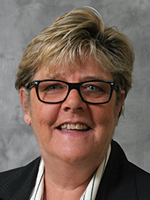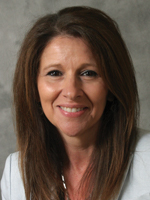Amy Carpenter Aquino
December 2017—After two rounds of a new program to train high schoolers in phlebotomy, OhioHealth is seeing the fruits of its efforts. It has hired 19 of its trainees and a third course, set to begin next month, has 20 high school seniors enrolled.

Byrnes
Just when OhioHealth’s phlebotomy staffing needs were expanding, laboratory services leaders were growing increasingly dissatisfied with the quality of the training students were receiving at most of the phlebotomy programs in the Columbus area.
“We were really only hiring phlebotomists from one of the programs because we didn’t feel the other programs were giving these students enough hands-on training,” says Marci H. Dop, OhioHealth system vice president for laboratory services.
OhioHealth’s ongoing draw site expansion, and competition for phlebotomists with national laboratories and Ohio State University Hospital, further depleted the supply of qualified phlebotomist candidates.
“We were all fighting for the same pool of phlebotomists, and somebody would raise their salary 50 cents and we would lose them,” Dop says.
In 2015, the Delaware Area Career Center reached out to OhioHealth to discuss a partnership that would add phlebotomy to the DACC’s established two-year health technology program for high school juniors and seniors. (The DACC’s college prep program prepares high school students for medical and health-related careers that require post-secondary education.)

Dop
OhioHealth jumped at the chance to prepare students to step into phlebotomy roles at any of its 66 laboratory sites. “We decided we could train our own and we didn’t need to depend on these other outside programs,” Dop says.
OhioHealth laboratory services management staff, including Karen Byrnes, director of laboratory services, created the phlebotomy program curriculum for seniors in their last semester of high school.
“Right from the beginning, we were trying to balance our needs and their needs,” Byrnes says, “and our needs for phlebotomists are that they have to be graduated from high school and 18 years old.”
Holding the phlebotomy training during the students’ final semester put the students’ relationship with OhioHealth as close as possible to graduation and their first job hunt.
“They don’t have to work for OhioHealth,” Byrnes says. “That’s my objective, but we are setting them up with the skills to go out and be a phlebotomist wherever they can.”
Byrnes and outreach phlebotomy manager Tina Manganello had experience teaching high school and college-level students, so they wrote the curriculum for 90 hours of in-class lectures and laboratory activities, including a review of the circulatory, skeletal, and respiratory systems, and the Clinical and Laboratory Standards Institute rules for venipuncture collection.
OhioHealth supplied all the instructional equipment for the students, such as centrifuges, while the DACC handled administrative duties and provided classroom space. “They have a lab attached to the classroom so the facilities were perfect for us,” Byrnes says.
Byrnes and two OhioHealth laboratory services managers taught the first phlebotomy course to 18 high school seniors during the second semester of the 2015–16 school year.
“We taught them venipuncture in class, making sure they had 30 to 40 sticks before we ever took them out on a clinical for real, live sticks,” Byrnes says. That sets the OhioHealth and DACC program apart from most of the other local phlebotomy programs in which students perform their first blood draws on patients in a clinical setting. “We want to make sure they are comfortable going in,” she explains.
The program’s emphasis on patient interaction is the key differentiator.
“The first thing we do is train them on how to interact with the patient. We do a lot of customer service training,” Dop says. “We actually bring in one of our phlebotomists who does a really good job at one of our draw sites, and she teaches them how to connect with the patient, how to make the patient feel confident that we’re going to do a good job. She’s a very compassionate person and goes through the whole conversation that you would have with a patient when they sit down in a chair to build their confidence when they’re stressed.”
Students toured the OhioHealth reference laboratory to get acclimated to specimen testing procedures and practiced patient interaction scenarios before working in a draw site. Once students were working in the draw sites, preceptors observed them drawing blood from patients and provided feedback on their interactions.
The education team focused on applied instruction for the last three months of the semester and paired students with preceptors for one-on-one training during internships at OhioHealth draw sites. Students completed 80 hours of hands-on learning in such areas as venipuncture, specimen processing, workflow, and customer service.
By leading the instruction, OhioHealth laboratory services leaders ensure that their students uphold the health system’s standards for phlebotomists.
“We train them on our OhioHealth mission and values,” Dop says, “so when they walk away to go into our draw sites, they already know what we are expecting.”
OhioHealth hired as phlebotomists nine of the 18 students who graduated from the 2016 DACC health technology course. The students who were not hired either had military commitments or plans to attend college outside the Central Ohio area, Byrnes says. She considers the first year of the program a success because all 18 students completed the classroom and clinical requirements and could have been hired as OhioHealth phlebotomists. “That was our ultimate goal,” she says. Some of the students who were not hired full-time routinely jump into OhioHealth’s contingent float pool when they return to Central Ohio for a holiday or summer break.
The program was equally successful this year, with OhioHealth hiring 10 of the 19 members of the graduating class. Twenty high school seniors are scheduled to start the phlebotomy component of the health technology program in January 2018, and the DACC has a wait list for its health technology program, Byrnes says.
“People are walking in specifically and asking for that phlebotomy program because it’s been so successful,” Dop says. “The students are happy to walk away and be able to get a nice job that they can either do full-time or part-time to help them get through college.”
OhioHealth recently added a full-time education coordinator to lead the classroom portion of the phlebotomy program at the DACC. When not teaching students, the education coordinator travels to OhioHealth draw sites to give refresher courses to phlebotomy staff.
The phlebotomy course has done much to alleviate OhioHealth’s staffing shortage but the program will need to expand.
“It’s much better; it’s not fixed,” Dop says of the phlebotomist shortage. “We’re hopeful that after this next batch of student graduates, we’ll be in a position where we can not only catch up but hire ahead.” To avoid overtime use, she would like to have staff on hand to fill in when phlebotomists are on vacation or medical leave.
Byrnes sees a need to hire more phlebotomists to help OhioHealth meet its goal of introducing draw sites to regional communities with no hospitals nearby. “With that kind of growth, we’re always needing phlebotomists.”
Reaching staffing goals will require expanding the phlebotomy program beyond high school seniors, Byrnes says, so OhioHealth is exploring the possibility of adding an adult learning program for phlebotomy at the DACC.
OhioHealth will use a different tactic to address its laboratory medical technician shortage, Dop says. The health system plans to work with a local temporary hiring agency to recruit college graduates with biology degrees who have been struggling to find full-time employment.
“You have a lot of students who got biology degrees who thought they were going to medical school and then it never worked out,” Dop says.
The plan includes hiring college graduates through the temporary employment agency and assigning them to work side by side with OhioHealth laboratory medical technicians. Program participants will receive instruction from an OhioHealth educator and take online courses. At the end of the two-year program, the graduates will sit for the American Society for Clinical Pathology medical laboratory technician certification exam.
“We’re hopeful we can start getting more techs through this program,” Dop says.
[hr]
Amy Carpenter Aquino is CAP TODAY senior editor.